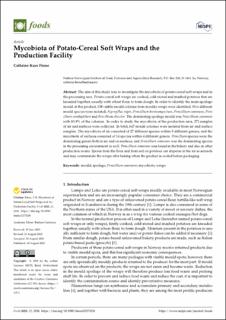| dc.description.abstract | The aim of this study was to investigate the mycobiota of potato-cereal soft wraps and in the processing area. Potato-cereal soft wraps are cooked, cold-stored and mashed potatoes that are kneaded together, usually with wheat flour, to form dough. In order to identify the main spoilage mould of this product, 150 visible mould colonies from mouldy wraps were identified. Five different mould species were isolated; Aspergillus niger, Penicillium brevicompactum, Penicillium commune, Penicllium corylophilum and Pencillium discolor. The dominating spoilage mould was Penicillium commune with 83.9% of the colonies. In order to study the mycobiota of the production area, 271 samples of air and surfaces were collected. In total, 647 mould colonies were isolated from air and surface samples. The mycobiota of air consisted of 27 different species within 9 different genera, and the mycobiota of surfaces consisted of 14 species within 4 different genera. Penicllium species were the dominating genera both in air and on surfaces, and Penicillium commune was the dominating species in the processing environment as well. Penicillium commune was found in the bakery and also in other production rooms. Spores from the flour and from soil on potatoes can disperse in the air as aerosols and may contaminate the wraps after baking when the product is cooled before packaging. | |
